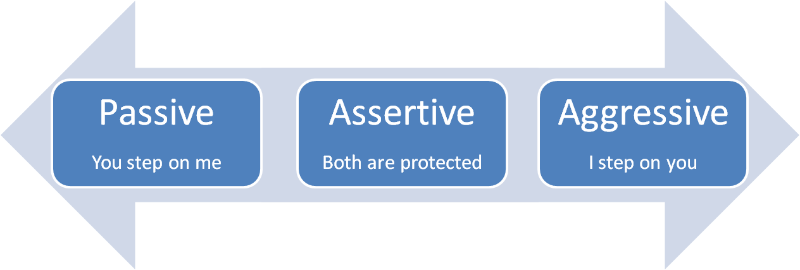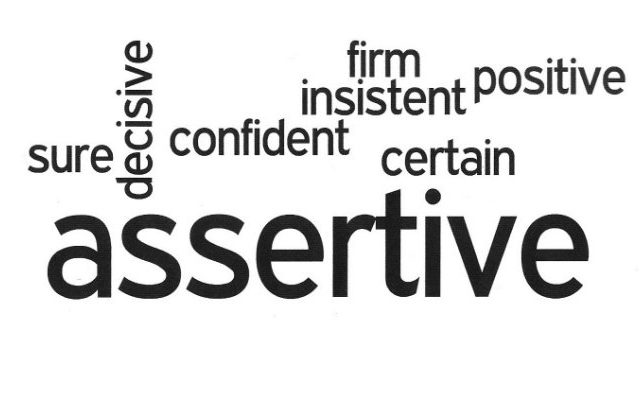When you say no to the wrong people, it opens up the space for the right people to come in. I have a tough time saying “No.” Possibly you do, too. I think it is more common than we ponder, especially for those who are empathetic or nurturing. We just hate the thought of hurting someone else’s feelings.

Have you ever appreciated a co-worker who’s able to steer challenging situations with ease and professionalism, no matter the politics and problematic personalities involved? Being assertive is a happy medium between the two extremes of aggressive and passive. While aggressive people adopt the “my way or the highway” stance, coming off as hostile and abrasive, passive people can be pushovers, giving up their power and allowing themselves to be taken advantage of, creating a surefire recipe for burnout and resentment.
At its very core, though, saying no is a refusal. Indeed, “no” has begun to possess a connotation attached to it that makes its very usage seem insulting. Why say “no” when you can just not call back, not RSVP, have sudden extraordinary circumstances appear as if by magic, or just say you never got the message?
“We need to learn the slow ‘yes’ and the quick ‘no.’”
Because we’re adults, and adults are expected to take responsibility for ourselves. Besides, saying “no” puts everything to rest. We aren’t forced to make excuses to back up the first one, we’ll be stand-up guys and it cuts down on stress. Assertive people, on the other hand, tend to seek out and create win-win scenarios. Assertive people understand the value of making their desires and beliefs known, but their pride isn’t damaged if their solution isn’t the one that comes out on top. Confident and assured, these people approach situations with a healthy dose of objectivity, and as a result, are able to communicate clearly and work through challenges in a low-stress, no-drama, and self-honoring way
#1: Getting the Squad after Your Idea
- Passive Approach: You wait for your boss to make the first suggestion, then take the path of least resistance by agreeing, rather than putting your idea on the table or even suggesting ways to improve upon her strategy.
- Aggressive Approach: You immediately present your “perfect” idea as the one the team needs to adopt and, without taking a breath, begin assigning tasks. If anyone tries to suggest an alternative, you shake your head and say, “That won’t work.”All the while, you’re pretending not to notice the eye-rolls happening around the table.
- Assertive Approach: As you listen to the various suggestions your colleagues are floating, you both acknowledge their strong points and assume a role in solving potential challenges. You might say, for example, “It’s a great idea to track prospective client interactions. What if we did it over six months instead of three? That would allow us to collect more data and make better decisions for the next fiscal year.”
#2: It’s Time for an Elevation, but Your Manager Isn’t Making Any Moves
- Passive Approach: You swallow your disappointment and nervously utter, “Oh, that’s fine—no problem,” to assuage the awkwardness of the situation. But later, you go home and complain about it for hours, because you feel it’s completely unjust.
- Aggressive Approach: After being told you’ll need to wait for a raise, you inform your boss that you’re going to begin to look for opportunities elsewhere—where someone will treat you like you deserve to be treated.
- Assertive Approach: Because you respect yourself and your need to be compensated fairly as much as you want to understand your boss’s reasoning, you don’t let your bruised ego get the best of you and lash out. Instead, you ask for more clarity on the company’s future and define tangible goals and targets that you can review when you revisit your salary request down the road.
#3: Handling the Team for Maximum Outcomes
- Passive Approach: Next time he turns in a terrible first draft of a report, you stay up until 2 AM redoing it on your own—and then fume about his poor performance to other colleagues when he’s not around.
- Aggressive Approach: Go full-on Jerry McGuire on him, demanding to know why he’s so stupid, assuring him that he’s nonviable anywhere else, and that you’re doing him a favor by not letting him go—all but firing him on the spot.
- Assertive Approach: In a private meeting, you clearly communicate why his work isn’t acceptable, pointing to his failure to satisfy core procedural requirements, but are careful not to take aim at his personal qualities. Binding your emotional intelligence and empathy, you invite him to let you know if there is anything else going on. Perhaps he’s struggling with personal issues that are detracting his focus from work. Or, maybe he’s not clear on your instructions. To keep projects on track and better your relationship, you schedule a weekly meeting to check in and create a channel for clear communication.

We find ourselves in a funny situation these days: We say “yes” to all the annoying schedule stretching requests, but say “no” to all the things that will help us grow as individuals. Growing up, many of us were taught that sharing is caring. We were expected to indulge requests because it showed we care.
At its purest, basest form, learning to say “no” is about attaining goals. Even if a person is eternally pledged to help others, it’s still a goal. While the Internet is brimming with advice about how to become a go-getter, become a goal-oriented person, or a success story, what these lists actually do—aside from normalizing words like “achievement” to the point that even blinking is considered a monumental occasion—is glaze over what happens between creating the list of goals and hopefully, just hopefully, checking off the box next to the final item. Elder recommends stepping back and viewing the decision as all-encompassing: A choice effects, potentially, all parts of our daily affairs and simply saying yes or no may interfere with plans we laid beforehand. Think before you speak? Got it. Learning how to say yes effectively is all about creating advantages. We may be the people that do stand up with the weight of the world on our shoulders.
“[If you never say yes] you’re going to miss out on exciting opportunities—you’re going to put yourself in a little box,” Elder says. “You’re going to limit some of the possibilities for your future.”
We often say “yes” because it yields revenue, but not all revenue is good. The bad kind of revenue sends us in a direction we shouldn’t or don’t want to go in. So ask yourself, what goal and purpose make you say “Yes!” and pump your fist? What makes you really happy?
The first step in becoming less of a pushover is establishing boundaries. Boundaries are rules and limits that a man creates for himself that guide and direct others as to what’s permissible behavior around him. Author Wayne Levine calls boundaries
N.U.Ts, or Non-negotiable, Unalterable Terms.
Your N.U.Ts are the things you’re committed to: your family, your health, your faith, your hobbies, your psychological well-being, etc. According to Levine, “N.U.T.s are the boundaries that define you as man, those things which, if repeatedly compromised, will gradually—but assuredly—turn you into a pissed-off, resentful man.”Once you have the mindset, here’s how to actually start being assertive.
– Start small- Say no- Be simple and direct- Use “I” statements- Don’t apologize or feel guilty for expressing a need/want/right- Use confident body language and tone- You don’t have to justify/explain your opinion/choices- Rehearse- Be persistent- Stay cool
“It takes effort to say no when our heart and brains and guts and, most important, pride are yearning to say yes. Practice.”
Share your feedback, It matters to me. G+:https://plus.google.com/+AnujTripathiI
LinkedIn: https://www.linkedin.com/in/refertoanuj
Twitter: https://twitter.com/refertoAnuj
Article by channel:
Everything you need to know about Digital Transformation
The best articles, news and events direct to your inbox
Read more articles tagged: Featured





